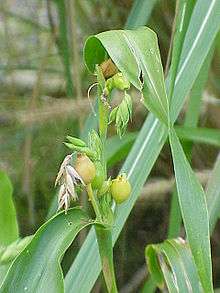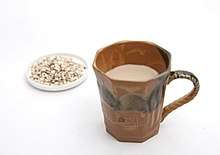Job's tears
Job's tears (US) or Job's-tears (UK),[2] scientific name Coix lacryma-jobi, also known as adlay or adlay millet,[3] is a tall grain-bearing perennial tropical plant of the family Poaceae (grass family). It is native to Southeast Asia[4] but elsewhere is cultivated in gardens as an annual. It has been naturalized in the southern United States and the New World tropics. In its native environment it is grown in higher areas where rice and corn do not grow well. Other common names include coixseed, tear grass and Yi Yi (from Chinese 薏苡 yìyǐ).[5] Job's tears are also commonly sold as Chinese pearl barley in Asian supermarkets, although C. lacryma-jobi is not closely related to barley (Hordeum vulgare).
| Job's tears | |
|---|---|
 | |
| Scientific classification | |
| Kingdom: | Plantae |
| Clade: | Tracheophytes |
| Clade: | Angiosperms |
| Clade: | Monocots |
| Clade: | Commelinids |
| Order: | Poales |
| Family: | Poaceae |
| Genus: | Coix |
| Species: | C. lacryma-jobi |
| Binomial name | |
| Coix lacryma-jobi L. | |
| Synonyms[1] | |
| |
There are two main varieties of the species, one wild and one cultivated. The wild variety, Coix lacryma-jobi var. lacryma-jobi, has hard-shelled pseudocarps—very hard, pearly white, oval structures used as beads for making rosaries, necklaces, and other objects. The cultivated variety Coix lacryma-jobi var. ma-yuen is harvested as a cereal crop, has a soft shell, and is used medicinally in parts of Asia.[6]
Taxonomy
The species was named by Carl Linnaeus in 1753 with the epithet as a Latin translation of the metaphorical tear of Job. As of February 2015, four varieties are accepted by the World Checklist of Selected Plant Families:[7]
- Coix lacryma-jobi var. lacryma-jobi. Widely distributed throughout the Indian subcontinent to peninsular Malaysia and Taiwan; naturalized elsewhere.
- Coix lacryma-jobi var. ma-yuen (Rom.Caill.) Stapf. South China to peninsular Malaysia and the Philippines.
- Coix lacryma-jobi var. puellarum (Balansa) A.Camus. Assam to Yunnan (China) and Indochina.
- Coix lacryma-jobi var. stenocarpa Oliv.. Eastern Himalayas to Indochina.
History
Residue on pottery from a Yangshao Culture site in China shows that Job's tears were used to brew beer as early as 3000 BC.[8] Remains of Job's tears have been found in archaeological sites in northeastern India, dating to around 1000 BC.[9]
Uses
Crafts
The hard, white grains of Job's tears have historically been used as beads to make necklaces and other objects. In both the Eastern Band of Cherokee Indians and the Cherokee Nation in Oklahoma, the beads of Job's tears are called "corn beads" or "Cherokee corn beads" and have been used for personal adornment.
Food
Job's tears grains are widely eaten as a cereal, and sometimes used as folk medicine.[10][11]
Throughout East Asia, Job's tears are available in dried form and cooked as a grain. The grains are generally spherical, with a groove on one end, and polished white in color. In Japan unpolished grains are also sold. In Korea, a thick drink called yulmu cha (율무차, literally "Job's tears tea") is made from powdered Job's tears. A similar drink, called yi ren jiang (薏仁漿), also appears in Chinese cuisine, and is made by simmering whole polished Job's tears in water and sweetening the resulting thin, cloudy liquid with sugar. The grains are usually strained from the liquid but may also be consumed separately or together. In southern China, Job's tears are often used in tong sui, a sweet dessert soup. One variety is called ching bou leung in Cantonese, and is also known as sâm bổ lượng in Vietnam.
In Cambodia, where it is known as skuay (ស្គួយ), it is used both as part of herbal medicine and as an ingredient in desserts. In Thailand, it is often consumed in teas and other drinks, such as soy milk.
Alcoholic beverages
In both Korea and China, distilled liquors are also made from the grain. One Korean liquor is called called okroju (옥로주; hanja: 玉露酒), which is made from rice and Job's tears. The grains are also brewed into beers in northeast India and other parts of southeast Asia.[9]
Traditional medicine
Job's tears are used alongside other herbs in traditional Chinese medicine. Particularly Coix lacryma-jobi var. ma-yuen has been used in the traditional Chinese medicine to invigorate the spleen function and promote urination, alleviate arthritis, arrest diarrhea, remove heat and facilitate the drainage of pus.[12]
Gallery
 An unripened head of Job's Tears
An unripened head of Job's Tears- C. lacryma-jobi plant with flowers and fruit in Nepal
.jpg) Job's tears grains
Job's tears grains Yulmu-cha (Job's tears tea) from Korea
Yulmu-cha (Job's tears tea) from Korea Yulmu-bap (Job's tears rice) from Korea
Yulmu-bap (Job's tears rice) from Korea Illustration of Coix lacryma-jobi from the Japanese encyclopedia Seikei Zusetsu (1804)
Illustration of Coix lacryma-jobi from the Japanese encyclopedia Seikei Zusetsu (1804) C. lacryma-jobi seeds in a necklace prepared in the Zulu tradition
C. lacryma-jobi seeds in a necklace prepared in the Zulu tradition
References
- The Plant List: A Working List of All Plant Species, retrieved 6 August 2017
- "BSBI List 2007". Botanical Society of Britain and Ireland. Archived from the original (xls) on 2015-01-25. Retrieved 2014-10-17.
- "Coix lacryma-jobi". Germplasm Resources Information Network (GRIN). Agricultural Research Service (ARS), United States Department of Agriculture (USDA).
- Taylor, G.D. (Autumn 1953). "Some crop distributions by tribes in upland Southeast Asia". Southwestern Journal of Anthropology. University of New Mexico. 9 (3): 296–308. doi:10.1086/soutjanth.9.3.3628701. JSTOR 3628701.
- http://www.herbalpedia.com/blog/?p=65
- Arora, R.K. (1977). "Job's tears (Coix lacryma-jobi) - a minor food and fodder crop of northeastern India". Economic Botany. 31 (3): 358–366. doi:10.1007/bf02866887.
- "Search for Coix lacryma-jobi". World Checklist of Selected Plant Families. Royal Botanic Gardens, Kew. Retrieved 2015-02-01.
- Wang, Jiajing; Liu, Li; Ball, Terry; Yu, Linjie; Li, Yuanqing; Xing, Fulai (2016). "Revealing a 5,000-u old beer recipe in China". Proceedings of the National Academy of Sciences. 113 (23): 6444–6448. doi:10.1073/pnas.1601465113. PMC 4988576. PMID 27217567. Retrieved 2016-06-03.
- Nesbitt, Mark (2005). Prance, Ghillean; Nesbitt, Mark (eds.). The Cultural History of Plants. Routledge. p. 53. ISBN 0415927463.
- Hill A.F. (1952). Economic Botany. McGraw-Hill.
- Duke J.A. (1983). Handbook of Energy Crops.
- Wang L, Waltenberger B, Pferschy-Wenzig EM, Blunder M, Liu X, Malainer C, Blazevic T, Schwaiger S, Rollinger JM, Heiss EH, Schuster D, Kopp B, Bauer R, Stuppner H, Dirsch VM, Atanasov AG (29 July 2014). "Natural product agonists of peroxisome proliferator-activated receptor gamma (PPARγ): a review". Biochem Pharmacol. 92 (1): 73–89. doi:10.1016/j.bcp.2014.07.018. PMC 4212005. PMID 25083916.
Further reading
- Flora of China, Vol. 22, pp. 648–649, Online
- Pink, A. (2004). Gardening for the Million. Project Gutenberg Literary Archive Foundation.
External links
| Wikispecies has information related to Coix lacryma-jobi |
| Wikimedia Commons has media related to Coix lacryma-jobi. |